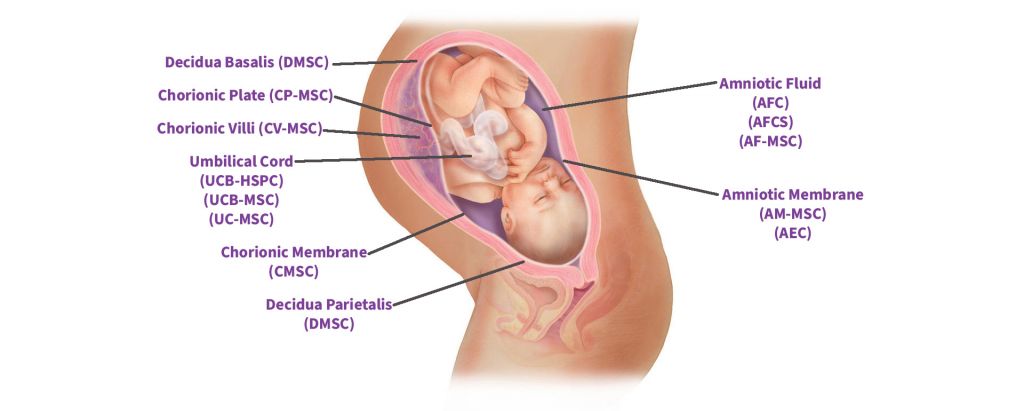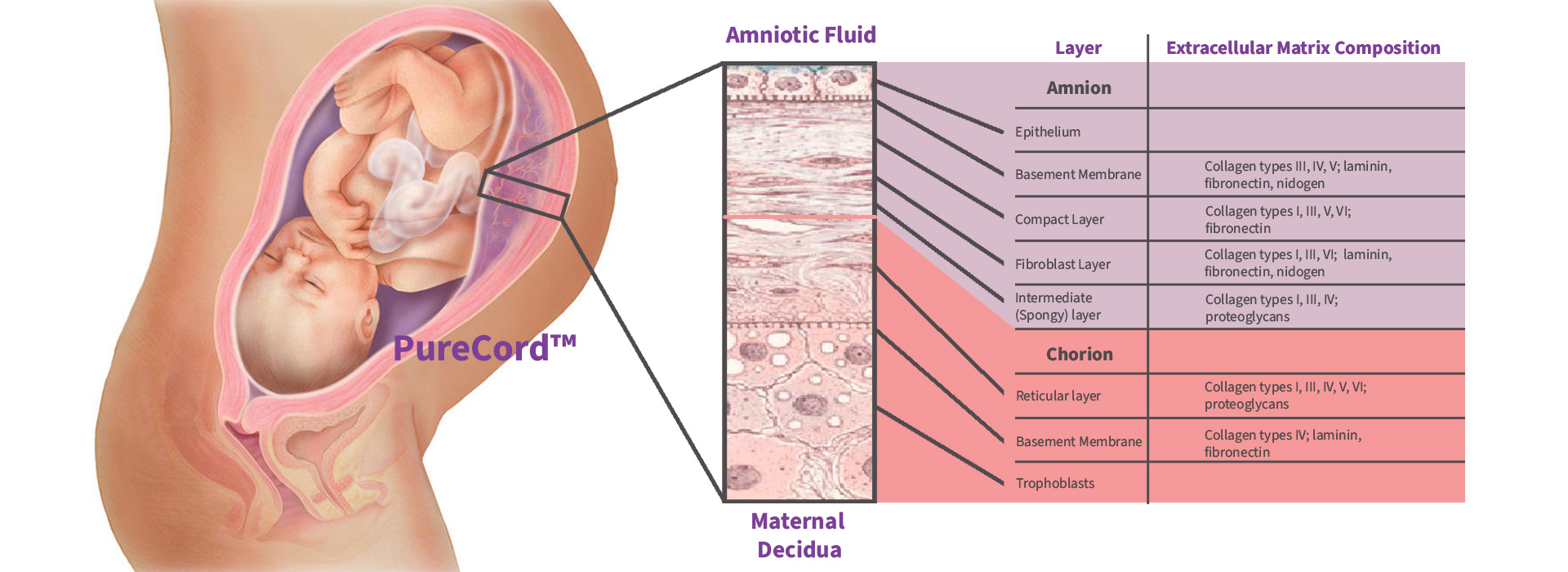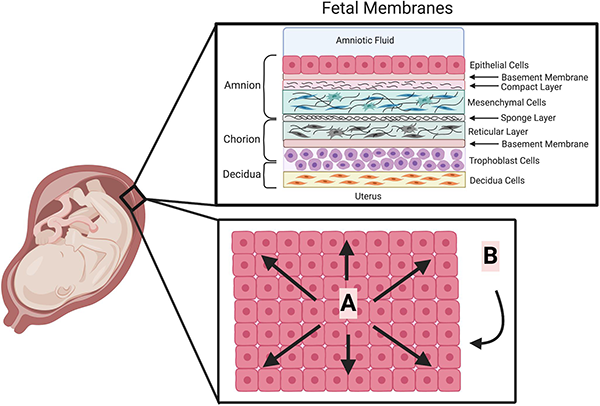PureCord™
Placental Tissue Banking
#1 choice of OB/GYNs,
Midwives and
expectant parents
for newborn stem cell preservation
Placental Tissue Banking
PureCord™
Placental Tissue Banking
#1 choice of OB/GYNs,
Midwives and
expectant parents
for newborn stem cell preservation
In order to extract the amnion and chorion layers of the placental tissue and preserve their natural multipotent cells, growth factors, and cytokines, PureCord developed the patented ExtractCryo™ processing procedure.
The amnion and chorion are cryopreserved and kept in numerous vials, guaranteeing that your child, siblings, parents, or grandparents can use them in a variety of ways. Families have the choice to employ therapeutic, wound, and ocular applications thanks to this processing technique, which also produces a tissue that is adaptable. Even more fascinating than the existing uses is the possibility. Trials using these stem cells are being conducted to develop new therapies for diseases like cancer, organ failure, heart disease, neurological dysfunction, and damage to the spine and joints.
The entire family should benefit from stem cell banking, which is why PureCord is the first and only cord blood bank to offer ExtractCryo™ Placental Processing.
While we recognise that the health of your children is your top concern, PureCord is dedicated to ensuring that the rest of your family leads healthier, longer lives using ExtractCryo™ Placental Processing. Your newborn and every other first- or second-degree relative can both be treated with these stem cells. In the event of a need, this entails that mum, dad, siblings, and even nan and grandad might utilise these cells. Giving your entire family access to the future of regenerative stem cell therapies is possible by banking this tissue.
What is Placental Tissue?
An organ with a disc shape that grows inside the uterus during pregnancy is called the placenta. It attaches to the infant through the umbilical cord. The newborn receives oxygen, nutrition, and waste-product removal from the umbilical cord.
During pregnancy, the placenta plays a crucial role. It shields the infant against viruses and bacteria by acting as a barrier. It also creates hormones and signalling molecules that aid in the development of the child.

PureCord™ collects up to twice as many stem cells as the industry standard.
PureCord™ collects up to twice as much Cord Blood as the industry standard.
View our Cord
Banking Packages
What is the importance
of Placental Tissue?
Amnion
- A thin translucent membrane containing multiple layers
- A thickness of ~44 microns
- Chorioncontains four to five times more growth factors/cytokines compared to Amnion
- Amniotic Epithelial Cells, Amniotic Mesenchymal Stem Cells
Chorion
- A thick opaque membrane containing multiple layers
- A thickness of ~188 microns – (roughly three to five times thicker than Amnion)
- Chorioncontains four to five times more growth factors/cytokines compared to Amnion
- Chorion Trophoblast Stem Cells

The Placental Membrane Contains:
-
Amniotic Epithelial Cells (AECs): Present on the top-most layer of amnion and can differentiate into various types of cells and tissue types.
-
Amniotic Mesenchymal Stem Cells (AMSCs): Multi-potent stem cells capable of differentiating into a number of different cells and tissue types.
-
Chorion Trophoblast Stem Cells (CTSCs): Present in the lowermost layer of chorion and are precursor cells of differentiated cells of the placenta responsible for oxygen and nutrient exchange.
-
Growth Factors: Signaling molecules that regulate cell growth and tissue regeneration.
-
Cytokines: Signaling molecules that regulate inflammation.
-
Extracellular Matrix (ECM): A three-dimensional structure consisting of various collagens and proteins that direct cellular behaviour such as differentiation, proliferation, and signalling.

Clinical Trials Using Placental Tissue
For more than a century, burns and wounds have been successfully treated with the placental membrane. The Johns Hopkins Hospital used it for the first time in 1910.
Currently being researched are amniotic mesenchymal stem cells and amniotic epithelial cells for:
-
Autoimmune diseases
-
Cancer
-
Graft vs Host disease
-
Gynaecological conditions
-
Lung diseases
-
Neurological disorders
-
Orthopaedic conditions
Several clinical trials are looking at placenta tissue that contains multipotent cells, growth factors, cytokines, and ECM. Scientists chose the amnion layer specifically because it has a structure like the skin and ocular surfaces:
-
Corneal Healing
-
Dry Eye
-
Chronic Venous Leg Ulcers
-
Diabetic Foot Ulcers
-
Knee Osteoarthritis
-
Pressure Ulcers
Placental Tissue Vs. Cord Blood
PureCord ExtractCryo™
Placental Tissue Processing
-
Chorion trophoblast stem cells, amniotic mesenchymal stem cells, and amniotic epithelial cells for therapeutic purposes.
-
Multipotent cells, growth factors, and cytokines are present in amniotic tissue (amnion + chorion), which is used in wound and eye applications.
Everything you need to know
about placental tissue banking
References:
- Davis J (1910) Skin transplantation with a review of 550 cases at the Johns Hopkins Hospital. Johns Hopkins Med J 15:307
- Sabella N (1913) Use of the fetal membranes in skin grafting. Med Rec 83:478–480
- Stern M (1913) The grafting of preserved amniotic membranes to burned and ulcerated surfaces, substituting skin grafts. JAMA 60:973
- Torre, Paz d.l., and Ana I. Flores. 2021. “Current Status and Future Prospects of Perinatal Stem Cells” Genes 12, no. 1: 6. https://doi.org/10.3390/genes12010006
- Elkhenany et al. Stem Cell Research & Therapy (2022) 13:8
- Zhang, Q., Lai, D. Application of human amniotic epithelial cells in regenerative medicine: a systematic review. Stem Cell Res Ther 11, 439 (2020). https://doi.org/10.1186/s13287-020-01951-w
- Front. Endocrinol., 02 October 2020 | https://doi.org/10.3389/fendo.2020.543623


